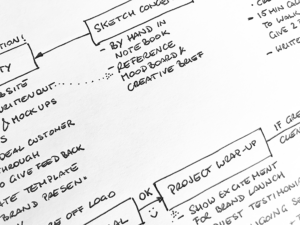
What Makes A Good App
Table of Contents
TLDR
What Makes a Good App (and What Doesn’t)
- A good app doesn’t start with features, it starts with a real problem.
- Design is about behaviour, not beauty. If it’s not intuitive, it’s broken.
- Tech choices aren’t about preference , they’re about performance under pressure.
- Most feature sets are bloated. Ruthless prioritisation wins.
- Security isn’t a backend concern, it’s a trust issue baked into UX.
- Real user testing beats internal opinions every time.
- Launch isn’t the goal. Retention is.
- Performance defines perception. If it lags, it fails.
- Iteration beats perfection. Build fast, watch behaviour, refine constantly.
If you want to build an app that gets used, not just launched, this is your playbook.
• • •
• • •
Let’s Kill the Checklist: What Actually Makes a Good App

Most teams start with a checklist.
- Nice UI?
- Fast load times?
- Push notifications?
But that’s not how great products get made.
“A good app doesn’t start with features. It starts with friction, something real users feel, every single day.”
And that’s the part most people skip. They jump straight to what makes a good app without ever understanding why it should exist.
We’ve been called in more than once to rescue projects that look the part, polished UI, decent stack, but still fail to land. One client built a beautiful mobile app with all the bells and whistles. But engagement flatlined. Why? It was solving a boardroom problem, not a customer one.
“It’s easy to fall in love with your idea. It’s harder to let the user reshape it.”
A successful app earns attention by design. Not just visual design, behavioural. Emotional. Contextual. It knows its moment of use. It solves one thing better than anything else. It makes the complex feel simple.
And a great app? That’s the one users keep. The one that quietly becomes part of their routine. Not because it shouted loudest on launch day, but because it worked, first time, every time.
“Your app’s not in competition with other apps. It’s in competition with the home screen.”
When we rebuilt a failing app for a mid-sized retailer, we didn’t start with design. We started with insight. We went back to the customer journey, mapped where intent broke down, and rebuilt from that moment out. One tiny feature shift made the app feel useful , and usage tripled in three months. That’s what a good app does.
If you want to build a successful mobile app, forget the features list. Start with the user, then work backward to the tech.
• • •
From Spark to Strategy: The App Idea That Matters

Every founder starts with an idea. But most never challenge it.
“The app idea isn’t the product. The problem is.”
Too many teams fall in love with their solution before they’ve earned the right to build. They’ve got screens in Figma and a dev team lined up, but they’ve skipped the hard bit: figuring out who it’s for, why it matters, and what behaviour it changes.
We always push clients to start with the target audience. Not a demographic, a moment. When does the user reach for their phone? What’s broken? What’s at stake?
It’s this depth of understanding that separates vanity builds from scalable products. Without clarity on your potential users, you’re just guessing. Great apps don’t aim for everyone, they serve someone incredibly well.
“If it’s for everyone, it’s for no one. Get specific, or get lost in the noise.”
This is where most app development projects drift. The founder wants flexibility. The investor wants a deck. The team wants to build. But no one’s pressure testing the why. That’s how apps get cluttered. That’s how budgets get burned.
One of our clients came in with a vague health tracking concept. After a few intense strategy sprints, the real opportunity wasn’t health, it was time. Specifically, helping carers save time with scheduling, alerts, and shared access. That shift in positioning changed everything, from roadmap to messaging. And it turned a generic tool into something that hit a very real nerve.
This is also where market research earns its keep. You don’t need a 40-page report. But you do need enough signal to know the user’s real-world alternatives. What they’re hacking together. What they’re already doing without you.
And the business objectives? These have to be brutally clear. Revenue model. Distribution path. Competitive moat. No one builds for fun. A successful app aligns user pain with business upside , and keeps both in scope as you move from idea to execution.
“Build for a user. Grow with a market. Scale with a model.”
If that sounds obvious, ask around. Most teams skip it. That’s why the app store is full of polished products nobody needs.
• • •
Designing for Humans: UX Is the Product

It doesn’t matter how beautiful your app looks if the user can’t work it out in five seconds flat.
“Design isn’t how it looks. It’s how it behaves under pressure.”
We’ve seen too many teams obsess over UI trends while missing the fundamentals. The user is tired, distracted, possibly mid-task, often on the move. They’re not analysing your colour scheme, they’re trying to get something done. That’s why a truly intuitive user interface doesn’t win awards. It just works.
In one of our most intense builds, a smart thermometer app, we weren’t just designing a dashboard. We were building something for sleep-deprived parents at 3am. That meant larger tap zones. Calmer colours. Clear state changes. No fiddly menus. The user interface wasn’t just a design asset, it was a trust layer.
“If your UI needs explaining, it’s already failed.”
This is where UX becomes the core product. Because when users are on a mobile device, they’re not sitting still. They’re walking, commuting, scrolling with one thumb. That context defines your patterns. It’s why just a few taps can be the difference between success and abandonment.
Apps that succeed in this space all feel effortless. But that effortlessness is engineered. Every action reduced. Every screen deliberate. And above all, the whole journey stays user friendly, not just during onboarding, but at every friction point.
We always build with behaviours in mind. Not personas, behaviours. How they think, what they fear, what they’re likely to do under time pressure. Designing for emotion is part of designing for flow.
And flow is what drives engagement. An app with a stunning UI but clunky interaction will lose users. Fast.
The goal isn’t beauty. It’s clarity. That’s the foundation of a user friendly experience, one that doesn’t just impress, but actually converts.
• • •
Build the Right Thing Right: Development Without the Drama

Great apps aren’t born from chaos. They’re built through clarity.
“Most delays in app development aren’t technical. They’re strategic drift dressed up as change requests.”
Development doesn’t have to be painful. But it becomes painful when teams don’t know what they’re building, or why. That’s why we front-load alignment, because a smart development team builds fast when the direction is sharp.
There’s no universal blueprint, but the rhythm matters: tight feedback loops, lean sprints, and constant learning from real usage. That’s the essence of a strong app development process, not just writing code, but making better decisions, faster.
We’ve rescued projects that spiralled for months with no launch in sight. Bloated feature lists, vague scope, and too many opinions. The fix? A strategy reset. Strip the noise. Lock in the must-haves. Build from the outcome backwards.
“If the team’s working hard but progress is unclear, it’s a process issue, not a resource one.”
A successful app development project hinges on alignment between founders, product leads, and engineers. That doesn’t mean everyone codes, but everyone must speak product. Especially when you’re dealing with evolving priorities or investor pressure.
This is also where technical expertise matters. Not just picking a stack, but making choices that support scale, security, and change. Knowing when to go native, when to reuse, and when to say no.
Case in point: a healthcare startup we supported had already burned through months of dev time. Solid tech stack, good intentions, but low adoption. We paused development, spoke directly to their target users, and rebuilt from that point forward. Half the planned features were dropped. Core workflows were rebuilt for clarity. The result: launch in eight weeks, daily active usage up 3×, and retention jumped from 12% to 45%.
Whether you’re running with an in house development team or an agency, the same truth applies: complexity kills velocity. Keep your product tight, your process lean, and your communication frictionless.
Because speed doesn’t come from rushing. It comes from knowing what not to build.
• • •
One App, Many Worlds: The Tech Decisions That Matter

TChoosing the right platform isn’t just a technical question, it’s a strategic one. Because what you build shapes who it’s for, how it behaves, and how quickly you can improve it.
“Platform choice isn’t about code. It’s about context, cost, and control.”
We’ve worked on builds where the wrong tech decision at the start cost six figures later. Not because the tech was bad, but because it didn’t match the user behaviour or business model.
Take operating systems. Most teams default to native iOS and Android, assuming that’s the gold standard. And sometimes it is. But for fast validation, a web app or hybrid stack often gets you further, faster. Especially if your users don’t care what it’s built in, they just want it to work.
One founder we worked with insisted on separate native builds. But their mobile application wasn’t doing anything a responsive web version couldn’t handle. After reframing around user behaviour, short bursts, light data entry, we rebuilt it as a PWA and cut dev time by half.
But it’s not just about platforms. It’s about trust, too. Users don’t want to think about user session authorization, or whether their data is secure. But you still have to get it right. That means everything from token validation to how you architect your application development process.
This is especially true when you’re handling sensitive data, payments, or logins. Invisible things like load speed, failover behaviour, and how you cache content affect perception. If the app stalls during onboarding, it’s game over.
“The user doesn’t see your tech stack. They feel it.”
And when your app needs to serve both iOS and Android users, the goal isn’t just parity. It’s performance. It’s deciding what gets reused, what’s custom, and what gets dropped for clarity.
In one travel utility app, we integrated Google Maps to handle live location and local search. But what mattered more was not the feature, it was how quickly it loaded and how intuitively users could act on the results. That’s the game: less tech theatre, more execution.
In short: the right build is the one that aligns with what your users actually do, not what your devs prefer to ship.
• • •
App Features That Stick: Crafting What Users Actually Want

Most feature lists are written in meetings, not in the wild.
“If your roadmap isn’t shaped by user behaviour, it’s just a wishlist.”
We’ve seen startups ship dozens of features users never asked for, never used, and never needed. Why? Because the team was building for potential, not priority.
A great product doesn’t try to do everything. It focuses on the core features that solve a real pain. Then, and only then, does it layer on extras that enhance the journey.
“New doesn’t mean better. Useful does.”
When planning features, we often use a value effort matrix and stack it against user insight. What’s non-negotiable? What drives revenue? What improves trust or retention?
That’s how we separate the noise from the signal. Because innovative features can still flop if they’re not solving a current need. And even key features can go unused if they’re buried behind poor flows.
One of our fintech clients planned 14 launch features. We shipped seven. The rest were deprioritised after we watched real users stumble through flows during beta. Post-launch? We added two more, based on actual demand. That discipline created velocity, and better outcomes.
We also look at how the app features work together. It’s not about volume, it’s about cohesion. Are they integrated? Do they reduce steps? Do they create a habit loop?
And then comes iteration. Rolling out new features isn’t just about writing code. It’s about sequencing. Testing. Communicating change. Otherwise, they don’t get used.
This is why many mobile apps struggle after launch. They confuse more with better. But when your users open the app, they’re there to get something done, not explore.
“Every feature you add makes it harder to be simple.”
Build less. Launch sooner. Learn faster.
• • •
Security Is UX: Why Trust Is Built in the Backend

Users don’t read your terms. They feel your trust.
“Security isn’t a feature. It’s a feeling.”
And that feeling starts from the first tap, when a user signs up, makes a payment, or shares personal data. If anything feels off, the journey stops. Fast.
We treat security not just as a backend checklist, but as part of the product experience. That means designing for trust. Building clarity into the process. And making sure your backend never becomes the front-end problem.
Case Study: Catch – Secure, Scalable Booking for Anglers
When we built Catch, a mobile platform for anglers and fisheries, security wasn’t optional, it was foundational. We were handling bookings, payment details, catch logs, and geo-sensitive fishing locations.
To protect that, we integrated token validation and stable user session authorisation, while keeping the interface friction-free.
We also stress-tested payment flows, ensured data protection was baked into onboarding, and ran regular security testing during development.
The result? Seamless bookings, zero trust issues, and a 3× increase in returning users over the first three months.
“If the app feels fragile, the product feels untrustworthy, no matter how secure it is.”
This is why even performance fixes, like failed refresh states or payment timeouts, become UX issues, not just dev tasks. Invisible backend decisions directly impact app’s functionality and how users feel inside the product.
Especially in environments like in app purchases, users don’t want to think about what’s happening behind the scenes. They just want to pay, confirm, and fish.
And while most users won’t understand the mechanics of sensitive data handling, they know what safety feels like. Fast loading. Clear confirmation. No surprises.
“The user doesn’t know your stack. But they’ll remember every glitch.”
Security, handled well, becomes part of the brand. It creates a sense of safety , not just for compliance, but for user engagement and loyalty.
Because when it works invisibly, it works brilliantly.
• • •
Testing, Learning, Releasing: Real Feedback Loops

You can’t build for emotion from inside a spreadsheet.
“If you’re not testing with users, you’re just guessing.”
That truth hit hard when we began building AiME, a voice-based mental health assistant designed to support people under real emotional stress. This wasn’t a casual consumer app. We were dealing with vulnerable users, fragmented attention, and real consequences if we got it wrong.
We didn’t start with screens. We started by listening.
Early conversations with target users revealed a mismatch between what they said they wanted (content, tools, advice) and what they actually needed in the moment: calm, clarity, and someone who’d just listen.
That insight shifted our roadmap. We restructured flows. Shortened inputs. Removed friction. Then we ran scenario-based sessions to test interactions in real-life conditions, late at night, post-stress, in moments of overwhelm. That’s where the product took shape.
“You can’t fake this stuff. You have to observe it.”
We conducted structured tests with both existing and potential users, focusing not just on clicks but on language, tone, and response fatigue. These tests became the foundation of AiME’s voice model, helping us deliver a more human experience.
We saw how tone affected user feedback. How pause length changed trust. And how emotionally intelligent flows outperformed logic-led ones.
That feedback loop informed everything from app performance (speed of responses, voice clarity) to retention. Without it, we’d have built something polished but pointless.
It also forced us to design for retention earlier. What keeps users engaged in a mental health context isn’t features — it’s relevance. Empathy. Timing. And a product that adapts.
“User testing is never finished. Because behaviour is never fixed.”
When you’re trying to retain users, that loop becomes your growth engine. It feeds design, content, development, and even marketing, because you’re building based on how people actually behave, not what you hope they’ll do.
And that’s the edge. The apps that grow fastest are the ones that listen best.
• • •
Launch ≠ Success: The Post-Launch Growth Engine

The App Store spike feels good. But it doesn’t last.
“Most apps die in the quiet weeks after launch, not because they’re bad, but because they stop evolving.”
At launch, everything feels urgent: squashing bugs, handling feedback, watching analytics in real-time. But once things stabilise, the real work begins, keeping users engaged, attracting new ones, and learning fast enough to stay ahead of churn.
We saw this play out with Catch, our platform for anglers and fisheries. After a clean launch, usage spiked, but retention dropped off by week two. Rather than panic, we ran short, focused surveys to understand friction points. One insight stood out: many users didn’t realise how much the app could do.
So we built a re-engagement loop, subtle, timely nudges tied to location, weather, and catch reports. We added mini walkthroughs for new features and incentives for feedback. We didn’t just fix bugs. We evolved.
Result: user retention jumped 36% over the next 60 days. New features like fishing spot tracking and in app messagingkept users coming back. And most importantly, we saw consistent growth, not just downloads, but usage.
“Launch is a milestone. Retention is the business.”
Keeping app users is harder than acquiring them. That’s why we build retention into the roadmap, with touchpoints, prompts, and adaptive content. It’s also why we monitor behaviour patterns obsessively: time to value, reactivation rate, dormant accounts.
For Catch, we shipped lightweight analytics tied to real-world behaviour, not just screen views. That helped us test and refine based on what users actually did. It also shaped how we handled user acquisition, doubling down on referrals and targeted campaigns that aligned with real usage moments.
It’s also why we regularly update. Not just for the sake of shipping, but because app’s success depends on learning loops. Push something small. Watch what happens. Improve. Repeat.
“You don’t need a growth team. You need a feedback engine.”
Great apps aren’t static. They’re systems, evolving through usage, feedback, and smart iteration.
That’s what keeps new users around. That’s what builds momentum. And that’s how you turn a successful mobile application into a long-term product.
• • •
Performance = Perception: The Silent Killer of Apps

You can build a beautiful app. Nail the flows. Get great feedback.
But if it’s slow, flaky, or crashes once, users won’t come back.
“Your UX is only as good as your worst-loading screen.”
Performance is emotional. A delay feels like doubt. A glitch feels like risk. And the user? They don’t wait around. They close the app and move on.
That’s why we treat app performance as core product work, not cleanup. Because users don’t separate visual design from responsiveness. They experience the whole thing as one impression: does this feel solid?
This is where polish becomes power. Every microinteraction, every loading state, every fallback matters. Together, they shape the user friendly experience that builds trust, even if the user never puts it into words.
Things like custom features, core features, or even personalized playlists won’t save you if the app doesn’t feel responsive. And visual appeal? It’s fragile. One delay and the whole product feels less valuable — no matter how visually appealing it is.
“Perceived speed beats real speed. Every time.”
The best apps don’t just work, they feel right. The user flows smoothly, gets answers instantly, and never second-guesses the tool in their hand.
So before you add another feature, fix the finish. Make it fast. Make it forgiving. Make it feel bulletproof.
Because a well designed app isn’t one the user talks about. It’s one they trust, use, and quietly recommend, without even realising it.
Thinking about building something serious?
We work with founders, CMOs, and digital leaders who need more than just a dev team. If you’re planning an app that has to work, scale, and deliver real value, let’s talk.
• • •
Top Sources Cited
- Google: JavaScript SEO BasicsHow Google crawls and renders JavaScript content https://developers.google.com/search/docs/crawling-indexing/javascript
- Google: Core Web Vitals OverviewExplains LCP, INP, CLS and their impact on rankings
https://web.dev/vitals/ - Google: hreflang for Multilingual SitesBest practices for structuring localised or multi-language pages https://developers.google.com/search/docs/specialty/international/localized-versions
- Google Search Console HelpHow to use URL Inspection and Coverage reports to troubleshoot visibility https://support.google.com/webmasters/answer/9012289
- Ahrefs: Why Your Page Isn’t RankingCommon reasons pages fail to perform in search—even when indexed https://ahrefs.com/blog/why-your-page-isnt-ranking/
- Yoast: SEO for JavaScript SitesWhat developers need to know about rendering, metadata, and structure
https://yoast.com/javascript-seo/ - Moz: Canonicalization Best PracticesHow to avoid duplicate content and consolidate ranking signals
https://moz.com/learn/seo/canonicalization - Search Engine Journal: Duplicate Content & GoogleWhat counts as duplicate content—and how Google handles it
https://www.searchenginejournal.com/duplicate-content-google/ - Smashing Magazine: Lazy Loading & SEOWhy lazy-loaded content often gets missed by crawlers
https://www.smashingmagazine.com/2021/06/lazy-loading-seo/ - Aleyda Solis: JavaScript SEO ChecklistA full audit guide for JavaScript-heavy websites
https://www.aleydasolis.com/en/search-engine-optimization/javascript-seo/
• • •





